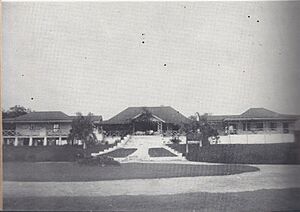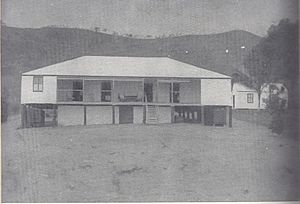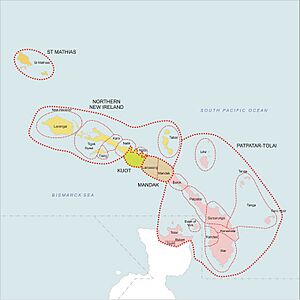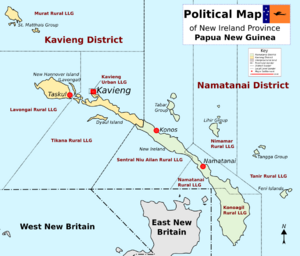New Ireland Province facts for kids
Quick facts for kids
New Ireland
Niu Ailan (Tok Pisin)
|
||
|---|---|---|
|
||
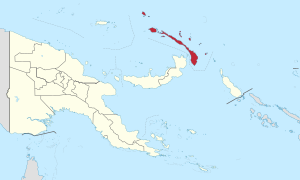
Location of New Ireland in Papua New Guinea
|
||
| Colony of German Empire | 3 November 1884 | |
| Australian occupation | 17 September 1914 | |
| Mandate of Australia | 1920/21 | |
| Union with the Territory of Papua | 1 July 1949 | |
| Province of Papua New Guinea | 9 September 1975 | |
| Capital and Largest city | Kavieng | |
| Administration | 10 local level government areas | |
| Government | ||
| • Type | Constitutional monarchy Parliamentary democracy |
|
| • Body | New Ireland Provincial Government | |
| Legislature | Parliament of New Ireland Legislative Assembly (10 seats) | |
| Federal representation | National Parliament of Papua New Guinea
|
|
| Area | ||
| • Land | 9,557 km2 (3,690 sq mi) | |
| Highest elevation
(Mount Taron)
|
2,340 m (7,680 ft) | |
| Population
(2021)
|
||
| • Total | 243,035 | |
| • Rank | 18th | |
| • Density rank | 6th | |
| Demonym(s) | New Irelander | |
| Time zone | UTC+10 (PGT) | |
| HDI (2019) | 0.598 medium · 4th of 22 |
|
New Ireland Province is a cool place in Papua New Guinea. It's located way up in the northeast! This province used to have different names like New Mecklenburg (from German) and Nova Hibernia (from Latin).
Contents
Discovering New Ireland
Where is New Ireland?
The biggest island in the province is also called New Ireland. But there are many other smaller islands that are part of this province too.
Some of these islands include the Saint Matthias Group (like Mussau and Emirau), New Hanover, and Djaul. You'll also find the Tabar Group (with Tabar, Tatau, and Simberi), Lihir, and the Tanga Group (Malendok, Boang). Finally, there are the Feni Islands (Ambitle, Babase), which are sometimes called the Anir Islands.
The land area of New Ireland Province is about 9,560 square kilometers. That's a lot of land! But the sea area around it, within its special economic zone, is much bigger, around 230,000 square kilometers.
Plants and Trees of New Ireland
Long ago, a French botanist named Jacques-Julien Houtou de Labillardière visited New Ireland. He was looking for a lost science trip. He noticed many teak trees growing at the southern end of the main island.
Teak is a very important tree for timber. It usually grows in places like India and Thailand. Finding it in New Ireland was special because it showed how far east these trees naturally grow.
New Ireland's Past
Early History and Explorers
People have been living in New Ireland for a very long time. There have been at least three big waves of people moving to the island over the last 40,000 years. About 3,300 years ago, the famous Lapita people, known for their pottery, lived here.
There might have been contact with people from China and Southeast Asia for many years, but there isn't much clear evidence.
The first Europeans to visit were Dutch explorers in 1616. At first, they thought New Ireland was part of another island called New Britain. But in 1767, a British explorer named Philip Carteret discovered that it was a separate island. He gave it the name Nova Hibernia, which means 'New Ireland' in Latin.
French and German Influence
In the 1870s and 1880s, a French nobleman tried to start a French colony on the island. He called it La Nouvelle France. He sent four groups of settlers, but sadly, many people died, especially during the third trip.
Missionaries started arriving in 1877. Then, in 1886, Germany took control of the island and named it Neu-Mecklenburg. This was part of Germany's control over the northern half of what is now Papua New Guinea.
During this time, a practice called "blackbirding" happened. This meant that young local men were often taken, sometimes by force, to work on farms in Australia and other Pacific islands. This was common in New Ireland, especially from Lihir Island and Tanga Islands.
World Wars and Independence
When World War I started in 1914, Australia took control of New Ireland. They renamed the island New Ireland after the country of Ireland. In 1921, the League of Nations (an organization like the United Nations) officially made it a territory managed by Australia.
During World War II, Japanese forces took over New Ireland from January 1942 to September 1945. After the war, Australia continued to manage the area.
Finally, in September 1975, Papua New Guinea became an independent country. New Ireland Province became a part of this new nation.
New Ireland's Economy
Today, the main parts of New Ireland's economy are farming, raising animals, and getting products from forests and the sea. There's also a lot of gold mining, especially on Lihir Island and Simberi Island.
People and Culture
Who Lives in New Ireland?
In 2000, about 118,350 people lived in New Ireland. Most of them (around 90%) live in small villages in the countryside. The population is quite young, with many people under 15 years old.
The capital city of the province is Kavieng. It's located at the northern tip of the main island. Another smaller town is Namatanai, which is about two-thirds of the way down the island. The Boluminski Highway runs along the east coast, connecting these two towns.
About twenty different languages are spoken in New Ireland! There are also many different ways these languages are spoken (dialects). Most of them belong to the Austronesian language family. However, one language, Kuot, is unique and doesn't seem related to the others.
Culture and Traditions
New Ireland, like many parts of Papua New Guinea, has a mix of old and new traditions. Traditional cultural practices, often called "custom," are very important and respected. But society is also changing because of churches, people moving to cities, and global culture.
One of the most famous cultural systems in New Ireland is called "Malagan". This is a word from the Nalik people. It refers to a very old and respected set of practices and ceremonies. These ceremonies are performed throughout much of the main island.
Malagan is also an art form. People create special carvings on Malagan masks to remember those who have passed away. These masks have deep symbolic meaning. They are a way to connect with the spirits of recently deceased family or clan members. Long ago, many Malagan masks were taken by European administrators and can now be seen in museums in Europe.
How New Ireland is Governed
Districts and Local Governments
Each province in Papua New Guinea is divided into smaller areas called districts. And each district has even smaller areas called Local Level Government (LLG) areas. These LLG areas are then divided into wards for counting people in a census.
Here are the districts and their LLG areas:
| District | District Capital | LLG Name |
|---|---|---|
| Kavieng District | Kavieng | Kavieng Urban |
| Lavongai Rural | ||
| Murat Rural | ||
| Tikana Rural | ||
| Namatanai District | Namatanai | Konoagil Rural |
| Namatanai Rural
Matalai Rural |
||
| Nimamar Rural | ||
| Sentral Niu Ailan Rural | ||
| Tanir Rural |
Provincial Leaders: Premiers and Governors
From 1977 to 1995, New Ireland Province was run by a local government led by a "Premier". After 1995, some changes were made. The national government took back some powers, and the role of Premier was replaced by a "Governor". The Governor is the person who wins the province-wide election to represent New Ireland in the National Parliament of Papua New Guinea.
Here are the Premiers who led New Ireland:
| Premier | Term |
|---|---|
| Robert Seeto | 1977–1986 |
| Pedi Anis | 1987–1990 |
| Demas Kavuvu | 1990–1993 |
| Samson Gila | 1993–1995 |
And here are the Governors who have led New Ireland since 1995:
| Governor | Term |
|---|---|
| Wilson Peni | 1995–1997 |
| Paul Tohian | 1997–2002 |
| Ian Ling-Stuckey | 2002–2007 |
| Julius Chan | 2007–present |
Representatives in National Parliament
New Ireland Province and each of its districts also have a person who represents them in the National Parliament of Papua New Guinea. There's one representative for the whole province, and one for each district.
| Electorate | Member |
|---|---|
| New Ireland Provincial | Julius Chan |
| Kavieng Open | Ian Ling-Stuckey |
| Namatanai Open | Walter Schnaubelt |
See also
 In Spanish: Provincia de Nueva Irlanda para niños
In Spanish: Provincia de Nueva Irlanda para niños



